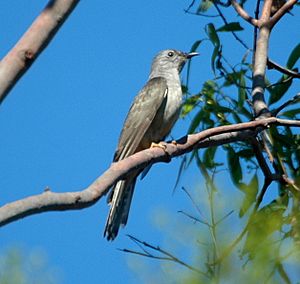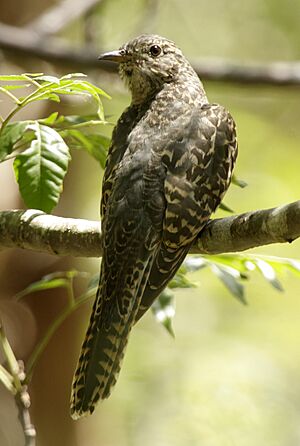Brush cuckoo facts for kids
Quick facts for kids Brush cuckoo |
|
|---|---|
 |
|
| Conservation status | |
| Scientific classification | |
| Genus: |
Cacomantis
|
| Species: |
variolosus
|
The brush cuckoo (Cacomantis variolosus) is a special bird from the cuckoo family. It's known for its unique call, which is a common sound in the Australian bush. This bird lives in places like Malesia, New Guinea, the Solomon Islands, and parts of northern and eastern Australia. It has grey-brown feathers and a light brown chest.
Contents
Understanding Brush Cuckoo Types
Scientists group living things into different types. For the brush cuckoo, there are twelve known types, called subspecies. These subspecies are slightly different from each other. They often live in different places.
Some of these subspecies include:
- Cacomantis variolosus addendus – Found in the Solomon Islands.
- Cacomantis variolosus aeruginosus – Lives in the central Maluku Islands.
- Cacomantis variolosus blandus – Found in the Admiralty Islands.
- Cacomantis variolosus dumetorum – Lives in northern Australia.
- Cacomantis variolosus everetti – Found in the Sulu Archipelago.
- Cacomantis variolosus infaustus – Lives in many islands near New Guinea.
- Cacomantis variolosus macrocercus – Found in the Bismarck Archipelago.
- Cacomantis variolosus oreophilus – Lives in the highlands of New Guinea.
- Cacomantis variolosus sepulcralis – Found across Southeast Asia.
- Cacomantis variolosus variolosus – Lives in southeastern Australia.
- Cacomantis variolosus virescens – Found in Sulawesi and nearby islands.
- Cacomantis variolosus websteri – Lives in New Hanover.
Sometimes, these different types meet up. For example, on Seram Island, brush cuckoos from Australia (variolosus) join the local ones (aeruginosus) during the southern winter.
Why Classifying Cuckoos Can Be Tricky
It can be hard for scientists to agree on how to classify these birds. This is because some subspecies look very similar. But their calls, which are their songs, can be quite different. For example, some experts think sepulcralis should be its own species, called the Rusty-breasted cuckoo. Others think aeruginosus should be a separate species, the Moluccan cuckoo. This shows how complex studying birds can be!
What Does a Brush Cuckoo Look Like?
The brush cuckoo is a medium-sized bird. It is about 22–26 cm (8.7–10.2 in) long. Both male and female brush cuckoos look alike.
Feather Colors and Markings
Their head is a light grey color. Their chest is a soft, light brown, which is called buff. The back of the bird is grey-brown. If you look at the underside of their tail, it's brown with white tips and stripes. They have a thin, light ring around their eyes. Their feet are a color called olive-pink.
Young brush cuckoos look different. Their feathers have many dark brown stripes. When they fly, their wings are pointed and sweep back. The feathers under their wings are grey-brown. They also have a light bar under their wings.
Similar Looking Birds
The brush cuckoo looks a bit like other cuckoos. It can be confused with the pallid cuckoo. It also looks similar to the fan-tailed cuckoo and the chestnut-breasted cuckoo.
Where Do Brush Cuckoos Live?
Brush cuckoos live in many places. You can find them in northern and eastern Australia. They also live in the Solomon Islands, New Guinea, and Malaysia. They are found on other islands north of Australia too.
Travel and Home Life
Some brush cuckoos stay in one place all year. These are called "resident" birds. They live in places like Thailand, the Philippines, and some Indonesian islands. Other brush cuckoos travel. They might move around locally in New Guinea. In southern Australia, they migrate, meaning they fly to different areas for parts of the year.
Favorite Places to Live
Brush cuckoos like many different kinds of homes. In Australia, they live in rainforests and at the edges of rainforests. They also like mangrove forests. You can find them in younger forests that have grown back, and even in tree plantations.
How Brush Cuckoos Raise Their Young
Brush cuckoos are known for being "brood parasites." This means they don't build their own nests. Instead, they lay their eggs in the nests of other bird species. The other birds then raise the cuckoo chicks as their own!
Egg Laying and Chick Behavior
In Australia, brush cuckoos use at least 58 different bird species as hosts. Some common hosts include the Ramsayornis birds, the scarlet robin, the leaden flycatcher, and the grey fantail. Female brush cuckoos are very clever. They lay different types of eggs that look like the eggs of their specific host bird. This helps the host bird not notice the cuckoo egg.
Once a brush cuckoo chick hatches, it does something amazing. It pushes the host bird's own eggs or chicks out of the nest. This way, the cuckoo chick gets all the food and attention from the host parents.
Media
See also
 In Spanish: Cuco varioloso para niños
In Spanish: Cuco varioloso para niños



